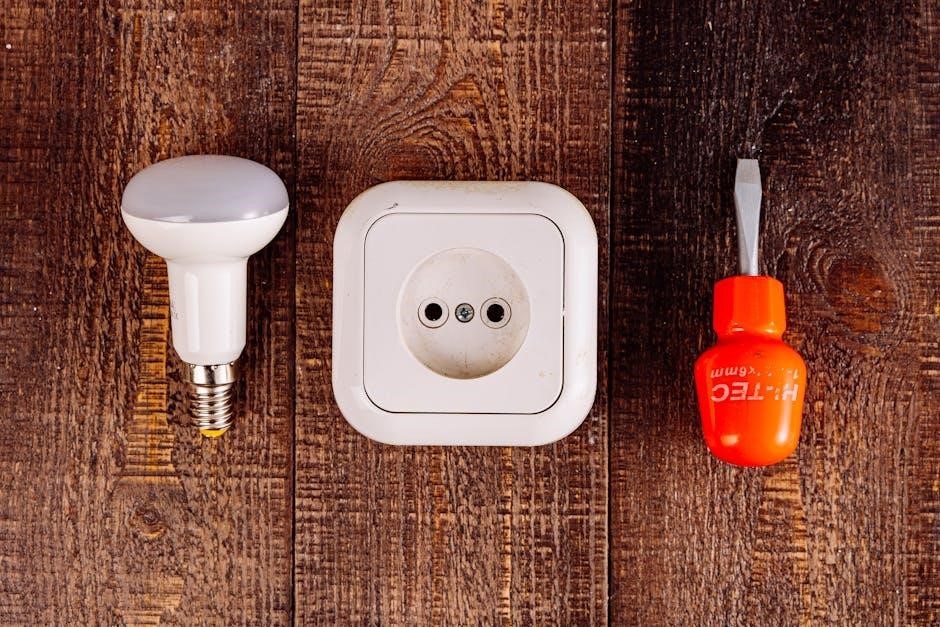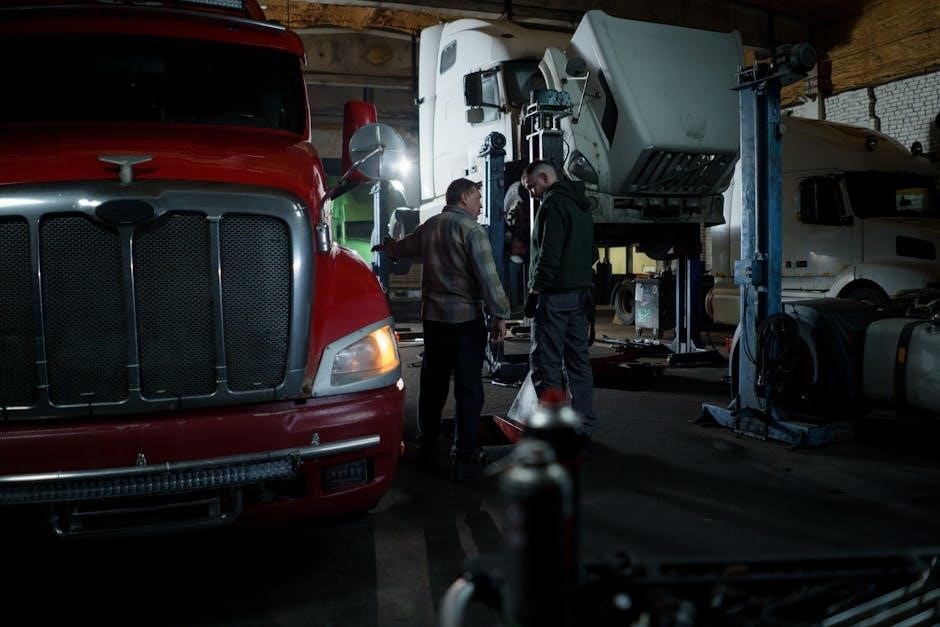RV repair and maintenance manuals are comprehensive guides offering detailed instructions for installation, maintenance, and troubleshooting․ They emphasize safety practices and proper procedures, ensuring efficient repairs․ Widely available online in PDF format, these manuals help RV owners maintain and repair their vehicles effectively․
Overview of RV Repair and Maintenance Manuals
RV repair and maintenance manuals provide detailed instructions for diagnosing, servicing, and repairing various RV systems․ They cover electrical, plumbing, HVAC, and appliance maintenance, ensuring owners can address issues effectively․ These manuals often include troubleshooting guides and safety protocols to prevent accidents․ Available in PDF formats, they are accessible online, offering step-by-step procedures for both routine and complex tasks․ Whether for seasonal maintenance or unexpected repairs, these manuals are essential for maintaining RV performance and longevity․
Importance of Regular Maintenance for RVs
Regular maintenance is critical for extending the lifespan of RVs and ensuring optimal performance․ It helps prevent costly repairs by identifying issues early․ Proper upkeep of fluid levels, filters, and systems maintains functionality and safety․ Neglecting maintenance can lead to system failures and reduced efficiency․ Following a schedule outlined in repair manuals ensures all components are inspected and serviced, keeping the RV in excellent condition for years of reliable use and enjoyment․
Understanding the Structure of RV Repair Manuals
RV repair manuals are organized into clear sections for easy navigation․ They typically include an overview, detailed instructions, and troubleshooting guides․ Manuals often feature diagrams and charts to illustrate complex procedures․ The structure ensures users can quickly locate information on specific systems, such as electrical or plumbing․ This logical arrangement makes it easier for both novices and experienced owners to perform maintenance and repairs efficiently, adhering to manufacturer guidelines for optimal results․

Essential Tools and Equipment for RV Maintenance
Essential tools for RV maintenance include wrenches, screwdrivers, and multimeters․ Specialized equipment like pressure gauges and fluid level testers are also crucial for diagnosing issues․ Familiarity with these tools enhances maintenance efficiency․
Basic Tools Every RV Owner Should Have
Every RV owner should have basic tools like wrenches, screwdrivers, pliers, and a multimeter․ These tools are essential for routine checks and minor repairs․ A toolkit with adjustable wrenches and screwdrivers can handle most tasks․ Additionally, torque wrenches and socket sets are useful for specific jobs․ Keeping these tools on hand ensures you’re prepared for common maintenance tasks, such as tightening connections or checking electrical systems․ Having the right tools can save time and prevent costly repairs down the road․
Specialized Equipment for Advanced Repairs
Advanced RV repairs often require specialized equipment, such as hydraulic pressure testers for plumbing systems or thermal imaging cameras to detect HVAC issues․ Diagnostic tools like multimeters and OBD-II scanners are crucial for troubleshooting electrical and engine problems․ Additionally, welding equipment may be needed for metal repairs, while alignment tools ensure proper axle alignment․ These tools are typically used by experienced RV owners or professionals to handle complex tasks efficiently, ensuring safety and precision in repairs․ Always refer to your RV repair manual for specific equipment recommendations․
Where to Source Tools and Equipment
Tools and equipment for RV repairs can be sourced from various suppliers, including online marketplaces and specialized RV stores․ Many RV forums and communities recommend trusted brands and retailers․ Official manufacturer websites often provide genuine parts and accessories․ Additionally, auto parts stores and hardware retailers carry essential items․ For rare or specific tools, RV dealerships or service centers may be the best option․ Always verify the quality and compatibility of tools with your RV model before purchasing․ Online reviews and manuals can guide your selection․

Preventive Maintenance Tasks
Preventive maintenance involves routine checks and inspections to ensure optimal RV performance․ Regular tasks include battery inspections, tire pressure checks, and fluid level monitoring to prevent breakdowns․

Routine Checks and Inspections
Routine Checks and Inspections
Regular inspections are crucial for maintaining RV performance and safety․ Owners should check electrical systems, plumbing connections, tire pressure, brakes, and HVAC function․ Use a checklist from your manual to ensure no component is overlooked․ Inspect for wear, leaks, or damage․ Record findings and schedule repairs as needed․ Monthly checks and pre-trip inspections can prevent breakdowns and ensure a safe, enjoyable journey․ Always refer to your RV repair manual for specific guidance tailored to your vehicle’s make and model․
Seasonal Maintenance Requirements
Seasonal Maintenance Requirements
Seasonal maintenance is essential for RV longevity․ Winterizing involves draining plumbing systems and protecting from freezing․ Spring checks focus on roof inspections and battery testing; Summer requires cooling system maintenance, while fall includes tire lubrication and storage preparation․ Refer to your manual for specific seasonal tasks to ensure your RV remains functional and safe year-round․ Regular updates from manuals help address climate-specific challenges and extend your vehicle’s lifespan․
Maintaining Fluid Levels and Filters
Maintaining Fluid Levels and Filters
Regular fluid checks and filter replacements are vital for optimal RV performance․ Ensure coolant, oil, and transmission levels are within recommended ranges․ Replace air and fuel filters as specified to prevent engine damage․ Inspect hydraulic and brake fluids for contamination․ Always use high-quality filters compatible with your RV’s systems․ Refer to your manual for specific intervals and procedures․ Proper maintenance of fluids and filters enhances efficiency, prevents overheating, and extends the lifespan of your RV’s engine and components․ Log your maintenance activities for future reference․

Troubleshooting Common RV Issues
Identify and address common RV problems like electrical faults, plumbing leaks, and appliance malfunctions․ Use diagnostic techniques to pinpoint issues and refer to manuals for solutions․ Professional help may be necessary for complex repairs․
Identifying Common Problems
RV repair manuals highlight common issues such as electrical faults, plumbing leaks, and appliance malfunctions; These guides provide detailed diagnostic steps to help owners identify problems early․
By understanding these manuals, RVers can pinpoint issues like faulty wiring, clogged water systems, or malfunctioning HVAC components․ Regular inspections and maintenance charts ensure proactive problem-solving․ Addressing these issues promptly prevents minor problems from escalating into costly repairs․ Always refer to troubleshooting sections for clear, step-by-step solutions․
Diagnostic Techniques for RV Systems
Diagnostic Techniques for RV Systems
RV repair manuals provide detailed diagnostic techniques for various systems, including electrical, plumbing, and HVAC․ They often include step-by-step troubleshooting guides to identify issues efficiently․
Techniques may involve using multimeters for electrical faults, pressure tests for water systems, or error codes for appliances․ Visual inspections and system checks are also emphasized․ These methods help owners pinpoint problems accurately and address them before they escalate, ensuring safe and effective repairs․
When to Call a Professional
When to Call a Professional
While RV repair manuals provide extensive guidance, certain issues require professional expertise․ Complex problems, such as advanced electrical faults or HVAC system overhauls, should be handled by trained technicians․
If repairs involve safety-critical systems like gas or high-voltage electrical components, professional assistance is essential․ Additionally, if the repair is beyond your skill level or tools, seeking help from an authorized service center ensures safety and warranty compliance․ Always prioritize professional intervention for intricate or hazardous tasks․

Detailed Repair Guides for Major RV Systems
Detailed repair guides for major RV systems provide step-by-step instructions for electrical, plumbing, HVAC, and appliance repairs․ They include diagrams and troubleshooting tips to ensure proper fixes․
Electrical System Repairs
RV electrical system repairs require careful attention to wiring, circuits, and components․ Manuals provide detailed troubleshooting guides and circuit diagrams to identify faults․ Common issues include blown fuses, faulty connectors, and malfunctioning appliances․ Regular inspection of wiring and connections is essential to prevent power failures․ Always disconnect the battery before starting repairs to ensure safety․ Refer to the manual for specific instructions on testing and replacing components, and never bypass safety protocols to avoid potential hazards․ Proper tools and knowledge are crucial for reliable electrical system maintenance․
Plumbing System Maintenance
Regular plumbing system maintenance is crucial for preventing leaks and ensuring water supply reliability․ Inspect hoses, connections, and valves for signs of wear or damage․ Drain and flush the water heater periodically to remove sediment․ Use RV-rated antifreeze to protect pipes during freezing temperatures․ Check the water pump and filters for proper function․ Address any leaks promptly to avoid water damage․ Always follow the manual’s guidelines for winterizing and maintaining your RV’s plumbing system to extend its lifespan and ensure optimal performance during trips․
HVAC System Troubleshooting
HVAC system troubleshooting involves identifying issues like poor airflow, uneven temperatures, or strange noises․ Check filters for cleanliness and ensure proper ventilation․ Verify thermostat settings and circuit breakers․ Inspect ducts for leaks or blockages․ Refer to the manual for specific diagnostic steps․ Addressing these issues promptly can prevent system failure and maintain comfort․ Always follow safety guidelines when working with electrical or gas components of the HVAC system to avoid hazards․
Appliance Repair and Service
Appliance repair and service are crucial for maintaining functionality in RVs․ Manuals provide detailed guides for troubleshooting common issues and performing routine maintenance․ Instructions often include step-by-step procedures for diagnosing and fixing problems, ensuring safety and efficiency․ Regular servicing extends appliance lifespan and prevents costly breakdowns․ By following manual guidelines, RV owners can address issues confidently, keeping their appliances in optimal condition for reliable performance during travel․

Safety Practices During Repairs
Always prioritize safety when performing RV repairs․ Ensure proper ventilation, disconnect power, and use personal protective equipment․ Follow manual guidelines to avoid accidents and injuries․
General Safety Guidelines
Always prioritize safety when performing RV repairs․ Ensure the vehicle is on level ground and apply brakes․ Disconnect power sources and turn off gas supply before starting work․ Avoid wearing loose clothing and use protective gear like gloves and goggles․ Follow the manual’s instructions and never attempt repairs beyond your skill level․ If unsure, consult a professional․ Keep flammable materials away and maintain good ventilation․ Regularly inspect tools and equipment for damage․ Adhere to manufacturer guidelines to prevent accidents and ensure a safe working environment․
Handling Electrical and Gas Systems Safely
When working with electrical systems, always disconnect power sources and verify voltage absence with a multimeter․ For gas systems, ensure valves are turned off and lines are purged before repairs․ Use approved tools and follow manual guidelines to avoid hazards․ Never smoke or use open flames near gas components․ Properly ventilate areas to prevent gas accumulation․ If unsure, consult a certified technician․ Always follow manufacturer instructions to ensure safe handling of electrical and gas systems, preventing potential accidents or damage․
Personal Protective Equipment
Always use personal protective equipment when performing RV repairs to ensure safety․ This includes gloves, safety glasses, and a face mask to protect against debris and chemicals․ Steel-toe boots are recommended for added foot protection․ Ensure proper ventilation when handling hazardous materials․ Never work near open flames or sparks without proper gear․ Refer to your RV manual for specific PPE recommendations based on the task․ Prioritizing safety with the right equipment helps prevent injuries and ensures a secure working environment during maintenance and repairs․

Accessing Resources and Support
Access RV repair manuals online through libraries or manufacturer websites․ Find resources like Trailer Life or Fleetwood RV guides․ Join online forums for community support and troubleshooting․
Where to Find RV Repair Manuals Online
RV repair and maintenance manuals are widely available online, often for free․ Websites like Fleetwood RV and Trailer Life offer extensive libraries organized by brand and model year․ These manuals are typically in PDF format, making them easy to download and access․ They cover a range of models and years, ensuring users can find the specific guide they need for their RV․ This convenient access helps owners maintain and repair their vehicles efficiently․
Online Communities and Forums
Online communities and forums are invaluable resources for RV owners seeking repair and maintenance guidance․ These platforms offer spaces to discuss repairs, share tips, and access shared knowledge․ Many forums provide troubleshooting tips and links to repair manuals, fostering a supportive environment for DIY enthusiasts․ Active participation allows users to ask questions and receive feedback from experienced RVers, enhancing their ability to maintain and repair their vehicles effectively․ These communities serve as a hub for collaborative learning and problem-solving, making RV maintenance more accessible and manageable․
Professional Repair Services
Professional repair services are essential for complex or specialized RV maintenance tasks․ Experienced technicians offer expert diagnostics and repairs, ensuring compliance with manufacturer guidelines․ These services often include warranty coverage and access to original parts, guaranteeing high-quality work․ Many RV dealerships and authorized service centers provide these services, while independent shops may also specialize in specific systems․ Professional repair services are particularly recommended for critical systems like electrical or plumbing, ensuring safety and reliability․ They also provide documentation of repairs, which can be useful for future maintenance tracking․

Scheduling and Tracking Maintenance
Regularly scheduling maintenance ensures optimal RV performance․ Use a calendar or digital tools to track inspections and repairs․ Manuals often include a maintenance chart for easy logging․
Creating a Maintenance Schedule
Developing a structured maintenance schedule is crucial for RV longevity․ Use charts from repair manuals to track routine inspections, fluid checks, and filter replacements․ Regularly log repairs and maintenance activities to ensure compliance with manufacturer guidelines․ Set reminders for seasonal tasks, such as winterization or tire inspections․ A well-organized schedule helps prevent breakdowns and ensures your RV operates smoothly year-round, while also maintaining warranty validity and resale value․
Logging Repair and Maintenance Activities
Keeping detailed records of all repairs and maintenance is essential for tracking your RV’s history․ Use the maintenance chart provided in repair manuals to document inspections, repairs, and replacements․ This helps ensure compliance with manufacturer guidelines and maintains warranty validity․ Organize records chronologically, noting dates, parts replaced, and services performed․ Consistent logging not only aids in troubleshooting but also enhances resale value by demonstrating proper care and adherence to maintenance schedules․
Reminders and Notifications
RV repair manuals often include reminders for routine maintenance tasks, ensuring owners stay on track with essential checks․ These notifications highlight critical service intervals, such as oil changes and filter replacements, to prevent system failures․ Many manuals also provide templates for creating maintenance schedules and offer digital tools or apps to set reminders․ Regular notifications help maintain optimal vehicle performance and extend the lifespan of components, ensuring safety and reliability on the road․

RV repair and maintenance manuals are invaluable resources for ensuring longevity and safety․ They provide comprehensive guidance, from routine checks to complex repairs, empowering owners to maintain their vehicles effectively and troubleshoot issues promptly, ensuring reliable performance and extended lifespan․
Final Thoughts on RV Maintenance
Regular RV maintenance is crucial for extending the life of your vehicle and ensuring safe, enjoyable journeys․ Repair and maintenance manuals serve as essential guides, providing detailed instructions for troubleshooting and repairs․ By following these manuals, owners can address issues promptly, prevent costly damages, and maintain optimal performance․ Consistent upkeep not only enhances safety but also preserves the value of your RV․ Encourage proactive care and utilize available resources to keep your RV in prime condition for years to come․
Encouragement for Ongoing Learning
Continuous learning is key to mastering RV maintenance and repair․ Stay updated with the latest manuals, guides, and online resources to enhance your skills․ Explore forums and communities for shared experiences and tips․ Regularly review repair manuals to familiarize yourself with new techniques and product updates․ Embrace a proactive approach to learning, as it empowers you to tackle challenges confidently and ensures your RV remains in top condition for safe and enjoyable travels․
Resources for Further Assistance
For additional guidance, numerous online resources offer detailed RV repair and maintenance manuals in PDF format․ Websites provide access to brand-specific manuals, such as Fleetwood RV and Trailer Life, covering various systems and components․ Online forums and communities also share valuable insights and tips from experienced RV owners․ Manufacturer websites often include troubleshooting guides and maintenance charts․ Downloading these resources ensures you have comprehensive support for all your RV maintenance needs, helping you stay informed and confident in your repairs․
